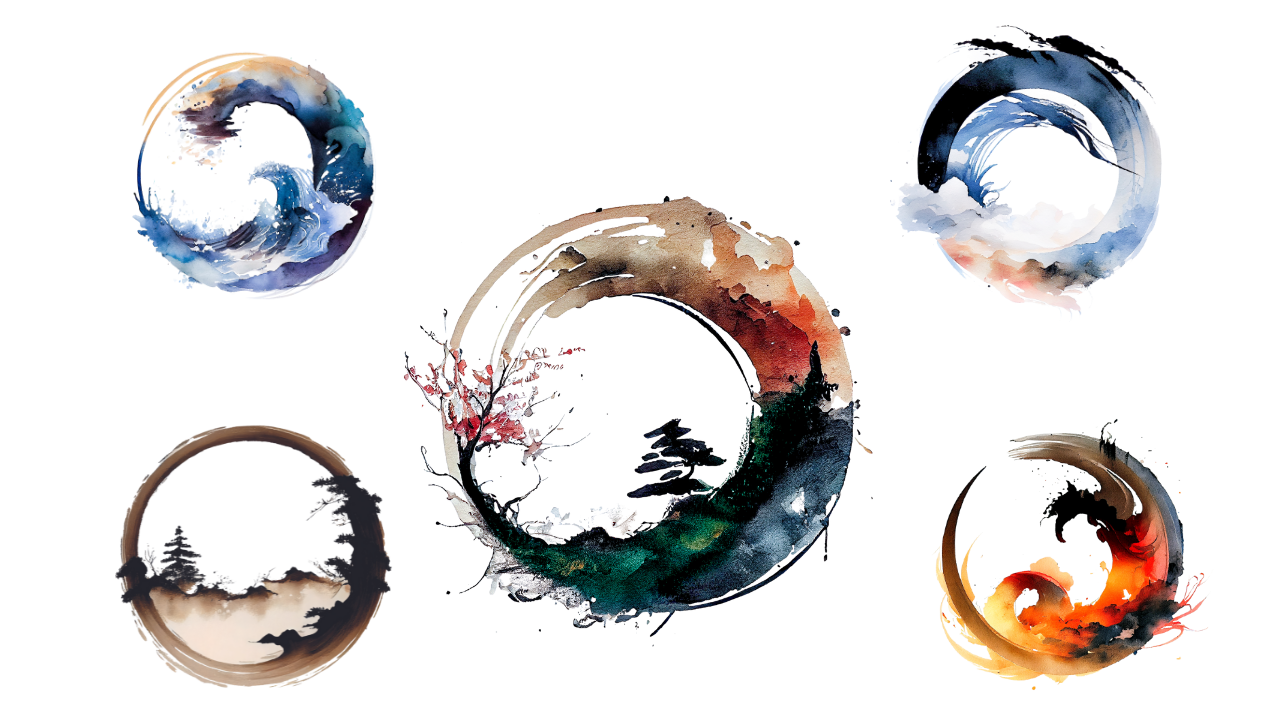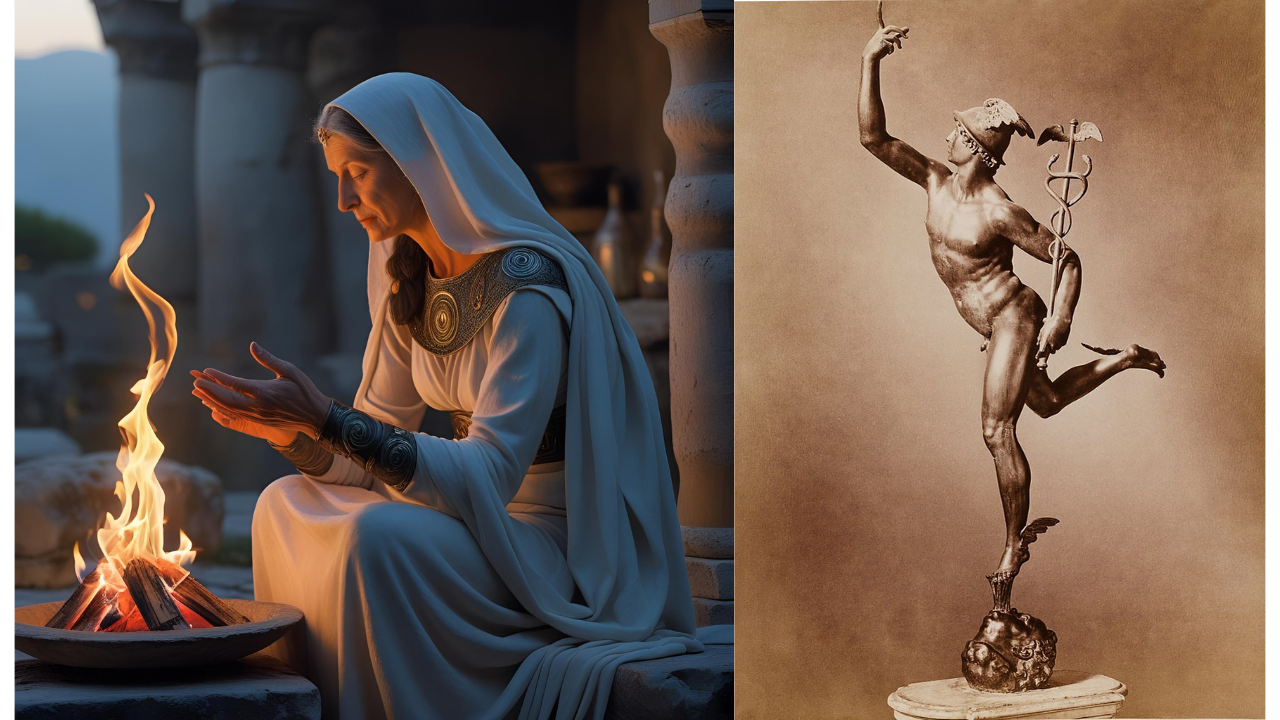Tending the Center and the Periphery: Using Greek Myths to Reflect on the Tao
The Tao that can be told is not the eternal Tao.
The name that can be named is not the eternal name.
The nameless is the beginning of heaven and earth.
The named is the mother of ten thousand things.
~Tao Te Ching, translated by Gia-Fu Feng and Jane English
The Unspoken Way
Before there were gods, before there were stories, before there were words to cage the wind—there was the Way. The Tao moves like breath beneath all breathing, like the silence that provides the matrix for music, like the empty hub that allows the wheel to turn. It is the source that never empties, the stillness around which all movement revolves.
Ancient wisdom traditions understood this mystery through their own stories and symbols. The Greeks, though separated by thousands of miles and centuries from Lao Tzu's insights, intuited the same eternal patterns. In their mythologies of Hestia and Hermes, they revealed the deepest secrets of how the Tao moves—through stillness and circulation, emptiness and form, the hub and the turning wheel.
In the beginning was this circular Way—both a path to walk and the walking itself, a destination out-there, and an eternal return in-here. The Tao flows like water through the ten thousand things, soft yet persistent, yielding yet inexorable, always completing the great circle—eternally recycling form back to emptiness back to form. It moves in great cycles beyond opposites—day becoming night becoming day, transitioning through dawn and dusk and sun and stars. Seasons turn into seasons, mountains rise from valleys only to be ground down to valleys again. Everything participates in the vast circulation between being and non-being, the eternal return that is the heartbeat of existence.
The intuition of the ancient Greeks
Listen: Hear the voice of wise Lao Tzu, speaking through the divine pairing of Hestia and Hermes. Goddess Hestia, keeper of home and hearth. Trickster-God Hermes, keeper of the crossroads. In their stories, we hear the echo of the empty hub and the turning wheel, the still center and the circular dance…
What makes this pairing of Hermes and Hestia so profound is what it is not. Hestia and Hermes are neither lovers locked in passion's drama, nor siblings caught in rivalry's web, nor enemies defined by opposition. Myth doesn’t trap them into the usual binaries of conflict and conquest, or into forced subservience due to familial or social bonds. Their stories unfold independent of each other. Yet, together, theirs is the dance of complementarity. Each is complete in themselves, yet each makes the other's existence more meaningful, like stillness and movement in the same breath.
This freedom from conventional relationship allows their story to breathe with the spaciousness of the Tao itself, which knows no enemies, plays no favorites, holds all opposites in the vast embrace of what simply is.
Hestia sits veiled in quiet majesty, her hands cupped around the first flame, tending the hearth fire that feeds all. She is the Tao's perfect stillness, the mysterious feminine that remains unmoved while giving birth to all movement. Her flame burns without consuming, gives without diminishing—the sacred emptiness around which the wheel of existence turns, the hub that makes all journeying possible.
See her now: eyes that hold the steady warmth of banked coals, presence serene as the center of a cyclone. She does not speak, for her silence is the axis around which all words revolve. In her quietude lives the patience of mountains that know they will return to sea, the constancy of seasons that understand their own circularity, the faithful stillness that allows the great wheel to turn.
And Hermes—the beautiful messenger—dances the Tao's circular movement. He lightly traces the rim of existence with feet shod in winged slippers, carrying understanding through the endless cycles of becoming. Trickster and guide, he embodies the Way's constant circulation between visible and invisible, known and unknown, what was and what will be again.
Watch him follow the natural curves of existence, his laughter echoing between sunrise and sunset, his footsteps writing spirals in starlight. He knows the deepest secret: that all journeys are circular, that every ending curves back into beginning, that the Way appears wherever we stop trying to make straight lines through the mystery.
Together they tell the story of how the Tao moves—through the empty center that enables all circulation, through the endless turning that always spirals home. She holds the hub; he traces the rim. She embodies the stillness; he dances the revolution. Yet neither exists without the other, for they are one wheel turning in the eternal Way.
When the Circle is Broken
To look for life
is to find death.
The thirteen organs of our living
are the thirteen organs of our dying.
Why are the organs of our life
where death enters us?
Because we hold too hard to living.
~ Tao Te Ching, translation by Ursula Le Guin
We have forgotten how to move in the Tao's great circles, trying instead to force existence into straight lines that go nowhere. We rush through our days like water trying to flow uphill, pushing against the natural patterns of rest and activity, forcing our bodies to ignore the ancient rhythms of light and dark.
Some of us move like Hermes torn from his hub—scattered in a thousand directions, our gift of circulation twisted into frantic spinning. Without Hestia's centered stillness, we race in smaller and smaller circles, burning through our days while forgetting how to rest in the empty spaces that make movement meaningful.
And some of us tend to swing toward the other extreme, becoming Hestia without her wheel—so rooted that we forget that the hub exists to enable turning. So centered-in-oneself that we become stuck, tending our inner fire while refusing to participate in the larger circulation of giving and receiving, speaking and listening, engaging and withdrawing.
We have forgotten that seasons turn, that everything in its time must rise and fall, that even our planetary home breathes in great cycles we are only beginning to understand. As a culture, we glorify living in permanent summer or perpetual growth, refusing the necessary deaths that make space for new life.
The Return to Circulation
Endlessly creating
Endlessly pulsating
The Spirit of the Valley never dies
She is called the Hidden Creator
Although She becomes the whole universe
Her immaculate purity is never lost
Although She assumes countless forms
Her true identity remains intact
~ Tao Te Ching, translation by Jonathan Star
The great wheel continues turning beneath our forgetting, patient as stone, fluid as water, waiting for our return to the circulation we never really left. To rewild our days is to remember the natural cycles, to let the rhythms of breath and heartbeat teach us how to move with rather than against the Way.
This begins with small acts of remembering: breathing fully enough to feel the circular exchange with the green earth, walking in ways that let our feet remember of her stability amid her continual turning, sitting still long enough to sense the great wheel of seasons moving through our bones. It means tending our inner hearth fire through practices that honor both the hub and the rim—meditation that roots us in stillness, action that flows from centered presence.
What if we choose rhythms over deadlines, cycles over straight-line thinking, patient circulation of seasons over the forced march of endless growth? What if we reminded each other, again and again, that true progress moves like the Tao itself—in spirals that deepen our intimacy with the source, in circles that always return us home transformed?
The Eternal Turning
The Tao gives birth to One.
One gives birth to Two.
Two gives birth to Three.
Three gives birth to all things.
…
Approach it and there is no beginning;
follow it and there is no end.
~ Tao Te Ching, translation by Stephen Mitchell
When we tend the Hestian hub while dancing the Hermetic rim, when we remember ourselves as temporary forms through which the eternal circulation flows, then we become what we have always been: partners in the great turning, servants of the wheel that grinds slowly and inexorably.
The path asks everything and nothing of us: to be still like the center of a wheel, fluid like the rim in motion, empty like the hub that makes turning possible, full like the circumference that contains the journey. To tend the sacred fire that burns in cycles, to fly on wings that know when to soar and when to rest, to dance the Way that spirals always deeper into the mystery of what simply is.
Listen: Somewhere, a hearth fire burns in the eternal now. Somewhere, a winged messenger traces the great circle between worlds. Somewhere, the Tao breathes itself through the endless turning of the wheel, world without end, always returning home.
An Invitation to Reflect
As you move through your days, notice: Where do you feel called to be more like Hestia—tending the still flame of presence, creating sacred space, offering the gift of your centered attention? And where might you embody Hermes—crossing boundaries with curiosity, carrying messages between different parts of your life, dancing at the edges of what's familiar?
Is there an imbalance between these two dance partners? How does that feel in your body? Do you notice a yearning for more balance, or is this truly a season in your life to embody one or the other archetype?
If this meditation speaks to you, I'd love to hear how these ancient patterns show up in your life. What does your inner hearth fire look like? How do you practice the art of sacred circulation? Please share your reflections below if you feel moved to do so.




Ooh I love this, so gorgeous! It's a rainy morning here and the air is much cooler than it's been... my being senses the breath of autumn as she slinks up behind us. I feel this as excitement in my bones for a deepening into the hearth fire of Hestia, into the silence and stillness of Mystery. Summer's eagerness - the frantic profusion of being - always tires me out, and I resist this running around the rim, longing to sit again in the dark. I feel this imbalance as heaviness, lethargy, reluctance, resistance.. and am inspired by your piece to consider how I could let go and allow myself to fall back into the cyclicality/seasonality with less clinging. My heart flutters at the feeling-sense of how it would be to come into the flow of the Great Way, rather than always trying to ford it toward some other shore. Thank you for this beautiful offering!
Beautiful! I love the interplay between Hestia and Hermes, which also reminds me of the interplay between the ancient and the emergent, something I think we need to deeply consider in this era where we face the danger of over-romanticizing the past in our efforts to wind our way toward the new kind of future.